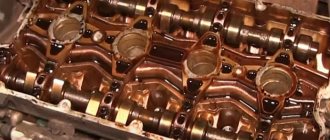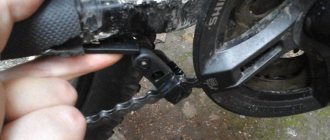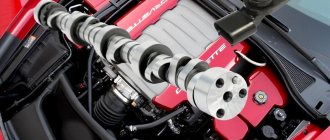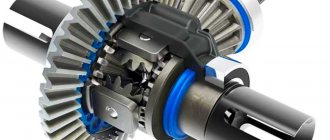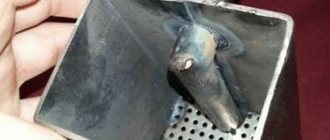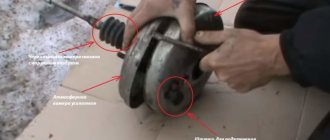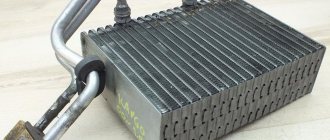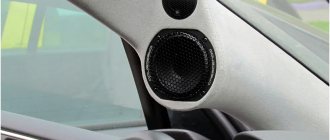Seat belts belong to the passive safety system of a car, and are also designed to reduce the likelihood of injury to the driver and passengers in an emergency. They can be conditionally divided into two groups - according to the type of fastening and the triggering system.
The fastening is:
- point-to-point;
- three-point;
- four-point or more (used mainly in sports cars).
Operating principles:
- static (not currently used);
- dynamic (most common);
- proactive.
The history of belts
The massive distribution of seat belts occurred in the 50s of the last century. This was due to the fact that at ever increasing speeds, accidents began to lead to quite serious injuries and often deaths.
Gustav Lebe, a French scientist, proposed installing five-point seat belts on cars back in 1903. But at that time his idea did not meet with much enthusiasm, and as a result, did not take root. During the research for the best design, more than a dozen devices were invented, but none of them, for a number of reasons, took root. Some are due to the complexity of the design and fastenings, others due to insufficient reliability.
Take, for example, the same two-point seat belts. Fixing the passenger or driver at waist level, in the event of a collision, they did not save them from hitting the dashboard, steering wheel or windshield. After all, the upper body was not fixed at all. Some GAZelle car models still have a similar mount (front seat next to the driver).
The pioneer, whose invention not only caught on, but also became widespread, and later became the progenitor of all modern three-point seat belts, was Nils Bohlin. An engineer from Sweden, who worked on ejection safety systems for an airline, came to Volvo and proposed a three-point system.
Article on the topic: The best sports cars of our time
Recommendations
No one can ever know when an accident will happen. An analysis of a huge number of videos of road accidents suggests that the survival rate in serious accidents is many times higher for passengers who were using the RB at the time of the accident.
Situations cannot be ruled out when an unbelted driver simply flew out of the vehicle at the moment of the first impact, which saved his life, taking into account the likelihood of the vehicle subsequently moving along an unpredictable trajectory or overturning.
It is important to note that fastening your seat belt before driving is one of the requirements of the Russian Traffic Regulations, for ignoring which a fine is provided. This obligation is fully justified, since in many road accidents the cause of serious injury or death is the unfastened vehicle.
Another reason why you should spend 10-15 seconds on a passive airbag system is the likelihood of getting a concussion, a broken nose, or other damage to the area of the body that comes into contact with a deployed airbag, even in a minor accident.
It should be noted that the opening speed of the PB is more than 300 km/h. Add to this value the speed of inertial movement and the final result is a very noticeable blow, in which loss of consciousness will be the least consequence.
Three point static seat belt
The design of this design was simple. Diagonal and waist strap with a lock that was fixed at the hip. The fastening is the same as in a modern car, with the only difference being that the fixation system was static. A significant drawback of this system is the need for adjustment. Having sat down and buckled up, the passenger had to adjust the fastening so that no more than two fingers could fit under the strap. If the length was greater, safety was again at risk. In the event of a collision, the body managed to gain acceleration before it encountered an obstacle in the form of a seat belt.
Components used in the design
The main element of this product is a tape made of polyester fibers. This material has high tensile strength and can withstand enormous loads. This tape is used to form a strap that holds the driver in a certain position and prevents the body from moving forward in a frontal collision. This, in turn, prevents the passenger from flying out of the car or colliding with the windshield, steering wheel, or front panel.
In addition, the seat belt design of modern models includes a number of other elements:
- adjustable and non-adjustable belt attachment points;
- lock;
- inertial coils;
- limiters;
- pretensioners.
But all these elements did not appear in the seat belt design right away. The history of these funds is very extensive, as evidenced by the considerable number of existing species.
Evolution of the belt
Inertial three-point seat belts, which replaced static ones in the 70s, were a breakthrough in the field of safety. They not only corrected the statistics of deaths and injuries in road accidents, but also almost doubled the number of people wearing seat belts. After all, there is no longer a need to adjust the belt when getting into the car. I sat down, buckled up, and the inertial reel itself took away the excess.
The design is such that in the event of an accident, the ball or pendulum mechanism of the reel fixes the tape and prevents it from unwinding, thereby securely holding the body. The inertial belt reel device blocks the belt when the car rolls over, in the event of a roll or skid, as well as during sudden braking. It would seem that three-point seat belts are ideal in terms of safety, but like any other, they have a significant drawback.
This is a delay in response, and in an accident, when the count is a fraction of a second, this delay can be dangerous. In winter, when a person is dressed in a large amount of clothing, the device creates that dangerous space between the belt and the body, as a result of which the body manages to gain serious speed. Therefore, the next stages in development were systems that operate proactively.
Article on the topic: The principle of operation of a car differential
Components and their purpose
Please note that not all components may be included in the design of safety equipment on certain models.
Fasteners
Let's start with the attachment points. They are often installed on body elements. This is due to the fact that the human body at the moment of inertial displacement forward creates a significant load on the belt. If you use an attachment point built into the seat, the structure may not be able to withstand the heavy load, and the backrest will move along with the body. In the case of mounting to the body, this will not happen.
But in devices with four or more points, some of them are still mounted in the seat (vertical straps). At the same time, we note that the design of seats in sports cars is much stiffer and is designed to withstand heavy loads, which is why it is possible to install fasteners in them. But as for the fastening of the lumbar strap, it is fixed to the body.
Now regarding the convenience of the attachment points (applies to the upper ones). The seat belts are comfortable because they extend above the shoulders. But the points on the counter can cause discomfort. If it is in a high position for short people, the diagonal part of the belt will run almost along the neck, which is not only inconvenient, but also unsafe. And for tall people, a low position of the top point will ensure that the belt passes below the shoulder, which will restrict arm movements. Therefore, manufacturers make the upper mounting points on the racks adjustable. No adjustment is required on fasteners located on the seats.
Lock
The lock provides a detachable fastening point. It also ensures the convenience of laying the straps. The operation of the lock is very simple - a hole is made on the tongue located on the belt, and a pin is used in the lock. When installing the tongue, the pin fits into the hole, thereby ensuring reliable fixation. To disconnect, you just need to press the special lock key to retract the pin and release the tab.
Inertia coils
The effectiveness of belts largely depends on their correct tension. Previously, for this it was necessary to adjust the length of the straps “to suit you” using special loops. This did not particularly cause problems for the driver, since he only needed to adjust the belt once. But passengers with different builds had to make adjustments every time.
Inertia reel mechanism
This problem disappeared with the advent of inertial coils. It provided automatic rewinding of the tape so that it would not interfere. You can only pull it back with a smooth movement. It is impossible to unwind the strap sharply with such a reel, since the mechanism blocks it during rapid unwinding.
Using an inertial reel solved several problems at once - when unfastened, the tape rewinds itself, which is very convenient. The reel also independently adjusts the tension by selecting the excess part of the belt. Another positive quality is that the reel locks during sudden unwinding. It prevents the belt from unwinding, so it “catches” the body, preventing it from moving forward too much. But there is also a negative quality - it is not blocked immediately, and the length of the belt still increases slightly, which is why the body has time to gain a slight acceleration. And this increases the likelihood of injury.
Limiters
The limiters allow you to slightly increase the length of the belt, but smoothly. The point is this: the body experiences significant overloads during inertial deflection. If you stop it abruptly, which is what the belt does, you may get injured. But if the strap slightly increases its length, this will partially absorb the energy and increase injury safety.
Torsion coil
The limiter is a torsion bar that acts as an axis for the coil. In the event of a collision, the reel blocks the unwinding of the belt, the body rests against the belt, which creates a load on the belt. When a certain force on the strap is reached, the torsion bar begins to twist, turning the reel and unwinding the belt. Because of this, a smooth release of force on the belt occurs. It is worth noting that the strap itself does the same. Polyester tape may stretch slightly when a significant load is placed on it.
Pretensioners
Pretensioners appeared on cars quite recently, but their role is significant. As already noted, the coil is not blocked immediately, so the body still receives acceleration. To prevent this, pretensioners are used, which tighten the belt even before the body begins inertial movement. That is, it prevents acceleration from being obtained. These devices work proactively and use impact sensors used in the design of airbags for this purpose.
Pretensioners work like this: at the moment of impact during a collision, sensors register it and send a signal to the control unit. That, in turn, engages the actuators, and they instantly tighten the tape, eliminating even the slightest forward movement of the body. There are two types of pretensioners - squib and electrically driven.
Electric pretensioner
Belt pretensioners
The first in this area were squibs, which, receiving a signal from the control system, when triggered, tightened the seat belt, the length decreased, reducing that same dangerous distance. To prevent the tension from being critically strong, the tensioner design contained a force limiter, a device that, when the load on the chest was exceeded (approximately 150 kg), began to give slack, thereby weakening the belt’s dead grip. The only drawback of these devices was and remains their disposability. After activation, the squib must be replaced.
The system of electric tensioners is completely free of this drawback. They are able to perform this action repeatedly. Working in conjunction with radars and sensors, they are able to determine critical proximity even before the moment of collision, which means protecting passengers and the driver in advance. If the device detects a danger, the length of the belt is shortened and the person is securely fixed in the chair.
How does it all work?
Finally, let’s look at the full operating principle of seat belts in modern cars. Let's take three-point type mechanisms as an example, since they are the most common.
So, the driver gets into the car and smoothly pulls out the tape until it is long enough to install and secure the tongue in the lock. After this, the inertial coil will select the excess, but not completely, so as not to hinder the driver’s movements. If the safety device is equipped with a pretensioner, then the function of the coil is completed.
At the moment of a collision, sensors register the impact and activate the pretensioners, causing the strap to tighten. As the force increases, the torsion bar comes into play, gradually increasing the length of the strap to absorb the force. Additionally, the belt itself is stretched.
If there are no pretensioners, then the function of holding the body is performed by the coil. A sharp acceleration of the body leads to blocking of the coil and the straps “catch” the body. Next, the torsion bar is used.
Other types of belts
There are also four-point and five-point harnesses. These are sports seat belts and are used to securely secure racing drivers. The first has four fastening points, and the second, respectively, five. The five-point seat belt is also used in child car seats that have recently become mandatory. This mount most reliably fixes the body and distributes the load on it.
Another variety has appeared called inflatable seat belts that fill with gas during an accident. The fastening of such belts is mainly three-point.
What conclusion can be drawn from all of the above? Many minds are concerned about the safety of the driver and passengers, many people are working to improve safety systems designed to save our lives and health. It's up to you to decide whether you should neglect this, but when getting into the car, remember that everything possible has been done for your safety; all you need to do is buckle up.
Share with friends on social networks:
Telegram
New developments
Developments to improve this security feature are ongoing. The latest innovation widely used on cars is pretensioners. But they are not the latest technology.
Tapes are already being developed that also act as pillows. The bottom line is that upon impact, it is filled with gas, due to which the area of contact of the body with the strap increases, which helps to better distribute the load and reduce injury.
They are also developing an electronic self-adaptive pretensioner system; depending on the use and stretching of the strap, it determines, according to given algorithms, the weight of the passenger and, accordingly, the required force to hold him at the time of the accident.
The most common breakdowns
Seat belt jammed
If you cannot pull the belt out of its socket, it means it is jammed. The problem can be eliminated on your own - most likely, the problem is in the latch - it is equipped with a special ball inside, which is responsible for the ease of movement of the belt in the mechanism. And it is with this that problems arise if the belt is pulled and pulled too sharply and quickly. Other reasons may include:
- freezing;
- accident.
In the latter case, you will not be able to deal with the problem yourself; only a service center mechanic will carry out the replacement.
Repair process
Now that we have dealt with the signals and reasons for blocking a fastened and unfastened seat belt, let’s move on to the repair process. Cleaning seat belts is one of the main tasks in this process, so we will consider this procedure separately. So, what should you do if you receive a signal that the lock is jammed? How can I clean it or turn it off? You will learn more about this below.
Tools
To disable the lock if a corresponding signal appears, the entire mechanism will need to be cleaned. To do this, you need to thoroughly prepare in advance and collect all the necessary tools. so what to prepare:
- a Phillips screwdriver, preferably a short one;
- flat head screwdriver;
- a wrench set to “17”, it will be more convenient to use a socket wrench;
- stationery pin;
- syringe with tube;
- some gasoline (lighter fuel is ideal).
Step by step instructions
When the entire list of tools is ready, you can begin repairing and cleaning.
- Using a Phillips screwdriver, unscrew the screws that secure the strap protection.
- If the lock is not working, pull the strap out to its full length and secure it with a clothespin.
- Take a wrench and remove the screw that secures the element coil. The screw must be removed from its installation location. To prevent the element from starting to unwind, you can attach it directly to the same spool using the same clothespin. In any case, in order to disable and clean the lock, it must be locked to make further actions easier.
- Put the reel aside and sit in the next seat. To disable and clean the lock, you will need to find the lid behind which the inertial device is hidden. As a rule, it is slightly thicker in design. Shake the coil - under which cover you hear the noise - under that one it is located.
- Now to dismantle the protective cover you will need to remove four plastic pistons. This can be done using a slotted screwdriver or a thin knitting needle. The pistons should be supported by hand so that they do not fly out and you do not have to look for them and collect them throughout the cabin. Then pry up the cover with a screwdriver and remove it. Set the lid aside.
- Your view will now be presented with the first mechanism of the component. It is a kind of box with a cylinder and thus a locking ball and a so-called rocker inside, which jams the lock. This mechanism can be dismantled freely from the installation site.
- Check the functionality of this rocker - ideally it should move freely along the axis of rotation. This device should be positioned vertically with the top angled toward the locking ball. One way or another, the rocker arm must be positioned vertically so that it does not jam. If you feel that the so-called rocker arm does not move freely, then you need to clean its rotation axis. Pour some gasoline and rinse the device until it rotates freely on the axis, without the slightest jamming.
- Now let's move on to the second, inertial device. It is located under the gear, which is made of plastic and in most cases is made of steel. The gear comes off freely, so remove it.
- Note the center of the serrated hole. It contains an eccentric with teeth. It is these teeth that jam the strap when it is suddenly pulled out. The space under this very eccentric needs to be cleaned. Pour a little prepared gasoline around the entire perimeter of the hole, add a little fuel to the center. At the same time, hold the strap, preventing it from winding up, for which you can temporarily remove the clothespin. Make sure that the liquid gets into all parts of the element, otherwise cleaning it will be useless.
- Take the dismantled spool with one hand so that the plastic guide along with the spring can be supported with one finger. Using your other hand, pull and wrap the safety element several times. Also pull it a few times until the device itself engages. Next, hook it on the reel one more time. These steps should be repeated several times.

